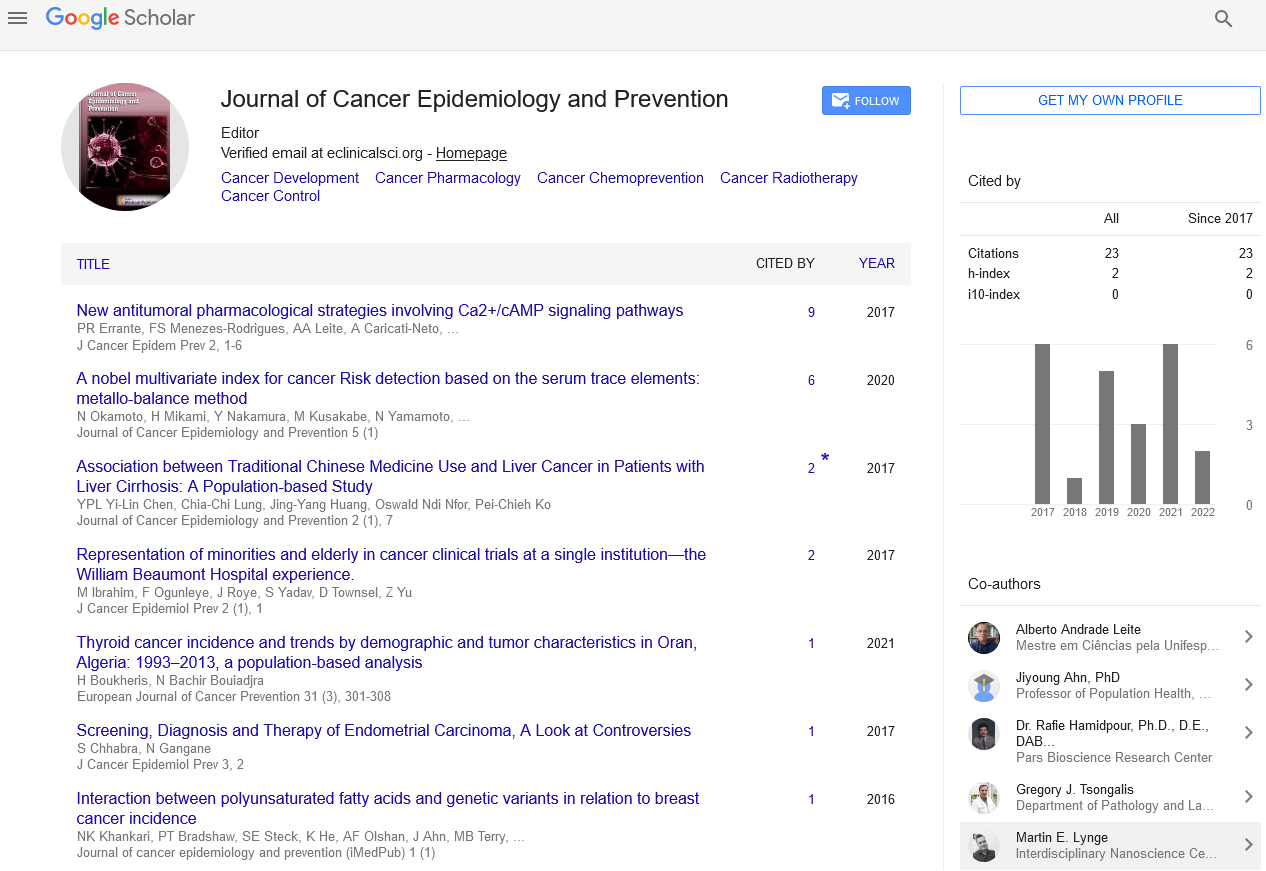Commentary - (2024) Volume 9, Issue 2
Comprehensive Guide to Cancer Prevention: Strategies, Research, and Lifestyle Choices
Mathew Robinson*
Department of Cancer Control, National Cancer Institute, USA
*Correspondence:
Mathew Robinson,
Department of Cancer Control, National Cancer Institute,
USA,
Email:
Received: 29-May-2024, Manuscript No. IPJCEP-24-20845;
Editor assigned: 31-May-2024, Pre QC No. IPJCEP-24-20845 (PQ);
Reviewed: 14-Jun-2024, QC No. IPJCEP-24-20845;
Revised: 19-Jun-2024, Manuscript No. IPJCEP-24-20845 (R);
Published:
26-Jun-2024, DOI: 10.36648/IPJCEP.9.2.13
Description
Cancer, a multifaceted and pervasive disease, remains one of
the greatest challenges to global health. Despite significant
advancements in treatment modalities, prevention remains
the cornerstone in reducing cancer incidence and mortality
rates worldwide. This comprehensive guide explores the
current state of cancer prevention, encompassing strategies,
research advancements, and the critical role of lifestyle choices
in mitigating cancer risks. Cancer is characterized by the
uncontrolled growth and spread of abnormal cells within the
body. The development of cancer is influenced by a complex
interplay of genetic, environmental, and lifestyle factors.
Understanding the root causes and risk factors is crucial for
developing effective prevention strategies. While inherited
genetic mutations can predispose individuals to certain
types of cancer (e.g., BRCA1 and BRCA2 mutations in breast
cancer), most cancers are caused by acquired mutations that
accumulate over a person’s lifetime due to environmental
exposures or lifestyle choices. Exposure to carcinogens such
as tobacco smoke, UV radiation, certain chemicals (e.g.,
asbestos), and pollutants increases the risk of developing
cancer. Occupational exposures and environmental pollution
are significant contributors to cancer incidence globally.
Smoking and second hand smoke exposure are leading causes
of lung, throat, and other cancers. Poor diet, high in processed
foods, red meat, and low in fruits and vegetables, is associated
with higher cancer risk. Regular exercise reduces the risk
of several cancers by maintaining healthy body weight and
reducing inflammation. Excessive alcohol consumption is linked
to increased risk of cancers of the liver, breast, and digestive
system. Early detection through screening plays a pivotal role in
improving cancer outcomes by identifying cancers at an early,
more treatable stage. Screening tests vary by cancer type and
include mammograms for breast cancer, colonoscopies for
colorectal cancer, Pap smears for cervical cancer, and PSA tests
for prostate cancer. Regular screening according to guidelines
helps detect cancer before symptoms appear, increasing the
chances of successful treatment. Vaccination against Human
Papillomavirus (HPV) significantly reduces the risk of cervical,
anal, and other HPV-related cancers. Protects against hepatitis B
virus infection, which can lead to liver cancer. Ongoing research
explores the potential of vaccines against other cancer-causing
viruses and antigens. Advancements in genomic sequencing
and molecular biology have deepened our understanding of
cancer biology, enabling. Tailoring treatment and prevention
strategies based on an individual’s genetic profile. Developing
drugs that target specific genetic mutations driving cancer
growth, improving treatment efficacy. Research continues to
explore the impact of lifestyle changes on cancer prevention.
Investigating the role of specific nutrients, antioxidants, and
dietary patterns in reducing cancer risk. Promoting smoking
cessation programs, healthy eating habits, and physical activity
to reduce cancer incidence. Implementing stricter regulations
on pollutants and carcinogenic substances in the workplace
and community. Educating the public about environmental
hazards and promoting safer practices to reduce exposure.
Certain medications and natural compounds show promise in
reducing cancer risk. Used for breast cancer prevention in highrisk
individuals. Potentially reduces the risk of colorectal cancer
and other cancers, though benefits must be weighed against
risks. Evidence-based programs encourage healthy behaviours
and reduce cancer risk.
Acknowledgement
None.
Conflict Of Interest
The author’s declared that they have no conflict of interest.
Citation: Robinson M (2024) Comprehensive Guide to Cancer Prevention: Strategies, Research, and Lifestyle Choices. J Cancer Epidemiol Prev. 9:13.
Copyright: © 2024 Robinson M. This is an open-access article distributed under the terms of the Creative Commons Attribution License, which permits unrestricted use, distribution, and reproduction in any medium, provided the original author and source are credited.

